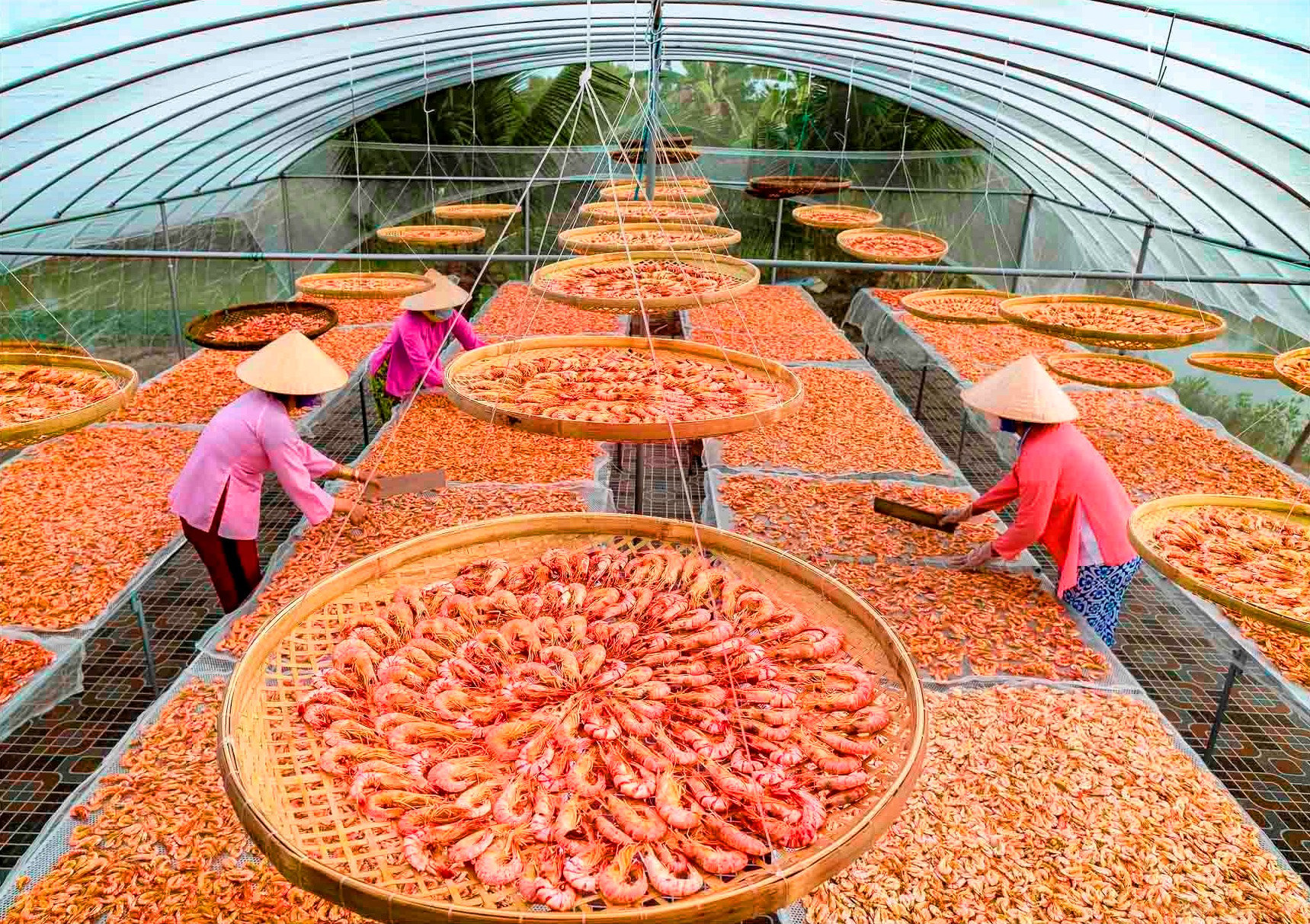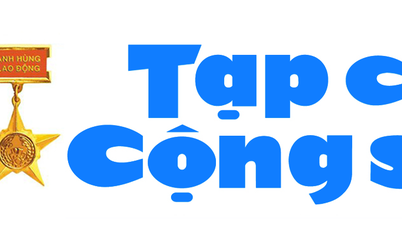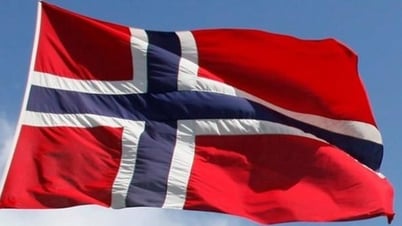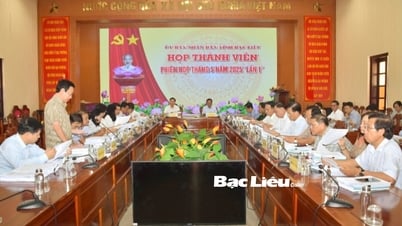The role of the informal economic sector in the Mekong Delta
In many countries around the world, especially in developing countries, the unobserved economic sector has long been identified as an important part of the economy. In our country, according to the Unobserved Economic Sector Statistics Project of the General Statistics Office ( Ministry of Planning and Investment ) in 2019, the unobserved economic sector is understood as a part of the unobserved economic sector, including non-agricultural, forestry and fishery production and business establishments, producing products (materials, services) for sale, exchange and not having to register for business.
Normally, in developing countries, the private economic sector helps about 60% of workers find employment opportunities (1) . In recent decades, with a strong growth trend, Vietnam's economy has recorded the development and significant contribution of the private economic sector. Accordingly, the private economic sector in our country is defined as "non-agricultural, forestry and fishery production and business establishments, producing products (materials, services) for sale, exchange and not having to register for business" (2) . Born from the years of recession of the planned economy, the private economic sector in our country has contributed to creating jobs, increasing income, eliminating hunger and reducing poverty for unskilled labor, freelance workers, workers whose jobs are affected in enterprises when the economy has major fluctuations; helping to improve the lives of low-income people, the poor in urban and rural areas. The activities of KTPCT in craft villages also play an important role in preserving, conserving and developing traditional occupations - a unique cultural feature of many regions and localities in the country. In recent years, according to many economic experts, the KTPCT sector in Vietnam accounts for about 30% of the national GDP (3) . In general, in all regions and areas in the country, the KTPCT sector has made significant contributions to the people's lives and the country's economy.
The Mekong Delta is an important economic region of our country, with outstanding characteristics of diversity in ecosystems, wetland resources, and an economy based mainly on agriculture , fisheries, small-scale handicraft production and small-scale services. This is a condition for the KTPCT region to exist and develop as an important "buffer" of the regional economy, creating job opportunities for millions of workers in the small-scale trading sector, hired labor, transportation services, seafood fishing, small-scale handicraft production, etc. The KTPCT region has made many contributions to the economic, cultural and social development of the region, becoming the main source of livelihood for millions of people, especially in rural areas.

For many years, the Mekong Delta has been considered a "lowland" in education and training in the country, many workers have low educational levels and do not have high professional skills, so developing KTPCT is suitable for the level and ability of the majority of human resources. In particular, the most common are small-scale trading activities (buying and selling at traditional markets, street vendors, sidewalk eateries, etc.); handicrafts, small-scale production (weaving water hyacinth, weaving mats, making traditional cakes, processing seafood at home, etc.); services (small waterway transport, small mechanical repairs, motorbike taxis, delivery, hired labor, house cleaning, etc.). These informal industries help improve income for many families, especially poor and near-poor households; workers who have difficulty or no access to job opportunities in the formal economic sector. The KTPCT flexibly and quickly meets the people's demand for goods and services, contributing significantly to the total economic output of the region. In particular, the network of small traders (traders) in the KTPCT plays a prominent role as a "bridge" between producers and consumers, especially in rural, remote and isolated areas. In the context of economic difficulties and instability (such as during the COVID-19 pandemic), the KTPCT area in the Mekong Delta not only helps many workers and families reduce losses due to unemployment and job loss, but also creates livelihoods for vulnerable groups, such as women, the elderly, people with disabilities, etc. Income from the KTPCT, although not guaranteed to be stable, is still an important source of livelihood for many households.
Income from informal economic activities such as small-scale trading, domestic work, motorbike taxi driving, delivery, etc. helps many households invest in their children's education, improving access to education. Informal activities in the field of community health care (traditional medicine, home health care, etc.) meet the needs of low-income people who lack access to medical facilities or health insurance. The informal economic activities in the Mekong Delta also create conditions for disadvantaged groups (who often have difficulty accessing formal employment) to participate in small-scale trading, production, and service activities, thereby enhancing community integration. Many informal economic activities such as handicraft production, trading on floating markets, traditional craft villages, local culinary services, etc. have made an important contribution to preserving and promoting the traditional cultural values of many localities in the Mekong Delta.
Issues of concern
Despite significant contributions to the economy, culture and society, according to some recent research results on the economy of the Mekong Delta, the Mekong Delta Economic Zone has been and is facing many issues of great concern.
Due to small scale of production and business, lack of capital, and outdated technology, activities in the KTPCT sector often have low productivity, and are not capable of investing in science and technology to improve product quality and value, so they have not created high added value, leading to limited competitiveness in the market and reduced ability to contribute to the overall economic growth of the region. The KTPCT sector in the Mekong Delta, which is mainly concentrated in the fields of agricultural production and small-scale business, is particularly strongly affected by external shocks, especially market fluctuations, climate change, and natural disasters. After the COVID-19 pandemic (2020 - 2021), many workers in the Mekong Delta lost their jobs in the formal sector and the impacts of drought, salinity intrusion, and climate change in recent years have pushed many agricultural workers to switch to small-scale trading, spontaneous services, and to seek seasonal or unstable non-agricultural jobs, increasing the number of workers in the KTPCT sector (4) . Due to the salinity intrusion causing many harmful effects on crop and aquaculture, many households in coastal provinces such as Ca Mau, Bac Lieu, Soc Trang, and Kien Giang have had to switch to non-agricultural jobs, with unstable incomes, much lower than those in the formal economic sector.
By the end of 2022, the average number of workers working in KTPCT establishments was mainly concentrated in two regions: the Red River Delta (mostly in Hanoi, Nam Dinh, Hung Yen) and the Mekong Delta (mostly in Can Tho, Tien Giang, Hau Giang, Kien Giang, Soc Trang, Can Tho, Bac Lieu) (5) . However, the rate of trained workers in the Mekong Delta region was only about 15%, lower than the national average (26%) and lower than the Central Highlands (17%) (6) . This data reflects the reality that the majority of workers in the Mekong Delta - the country's key food region - are working in small-scale household economic models in the KTPCT sector (small trade, aquaculture, agricultural processing, etc.) are unskilled workers, without professional training, mainly working based on experience, personal skills, and poor ability to apply technology. Like many other regions, due to the lack of formal labor contracts and social insurance, the majority of workers in the KTPCT area in the Mekong Delta often do not enjoy social insurance benefits, social security support, and occupational safety. This situation makes them vulnerable to economic fluctuations or risks in the production and business process.
Due to the limited and unclear policies and support for the KTPCT area, many small production and business households in the KTPCT area in the Mekong Delta face many difficulties in accessing credit capital from banks, due to lack of collateral and legal documents. On the other hand, the management, control and supervision of the KTPCT area according to legal regulations on tax, labor, environment, etc. face many difficulties (due to the dispersed and spontaneous nature of this economic area). This leads to many spontaneous activities such as street vending, street trading, small-scale handicraft production, aquaculture, agricultural processing, etc., which easily cause environmental pollution, unsanitary conditions, and reduce urban aesthetics.

Creating conditions for the informal economic sector in the Mekong Delta to develop in the right direction
In the process of building a socialist-oriented market economy, together with the formal economic sector, the existence of the private economic sector is inevitable and has become an important component of the economy. The trend of increasingly deep international integration and the strong development of the Fourth Industrial Revolution along with the emergence of a series of new technologies have affected all fields, economic sectors, and the economy, including the private economic sector. In that trend, "both in the short term and in the long term, the first and consistent requirement is to mobilize all economic sectors, all enterprises, and people to participate in socio-economic development, actively work in production, and create material wealth to contribute to the growth and development of the country. All institutions, mechanisms, and policies must aim at and achieve this requirement" (7) .
In the Mekong Delta region, in recent years, the strong trend of digital transformation in the economic sector has prompted many establishments in the KTPCT sector to change their operating methods, focusing on accessing digital technologies to improve efficiency in production and business. In general, the KTPCT sector continues to develop along with the process of new rural construction, urbanization, and economic growth of the region and the whole country. The problem is to correctly identify the nature, have the right viewpoints and approaches to policies for the KTPCT sector, thereby having appropriate solutions to promote positive aspects, minimize limitations and shortcomings, helping this economic sector develop in the right direction, contributing to "Developing the Mekong Delta in accordance with the socio-economic development strategy of the whole country, consistent with the national planning system; in accordance with the sustainable development strategy, the national green growth strategy, and adaptation to climate change" (8) .
In the coming time, to create conditions for the KTPCT area in the Mekong Delta to develop in the right direction, contributing to the rapid and sustainable development of the country's economy, it is necessary to pay attention to synchronously implementing the following solutions:
Firstly, strengthen theoretical research, summarize practices, and refer to international experiences to raise awareness of the role of the KTPCT sector in the process of building and developing a socialist-oriented market economy; focus on discovering issues that need to be addressed in terms of policies and guidelines, especially ensuring legal rights regarding labor, social insurance, and social security for workers in this sector in line with the trend of international integration and the context and conditions of our country. At the same time, continue to build and perfect institutions and policies to support the KTPCT sector in the direction that the State ensures the role of leadership, organization, and management so that the KTPCT sector continues to promote its role and value in the country's economy.
Second , along with strengthening law enforcement capacity and administrative responsibility to improve the relationship between administrative agencies and production and business establishments in the KTPCT area, local authorities in the Mekong Delta need to conduct surveys, statistics, and correctly assess the current situation and role of the KTPCT area, and include this economic sector in local and regional socio-economic development programs, thereby having support policies, creating conditions for business licensing, capital support, tax support, business skills training, etc. to encourage KTPCT establishments to rise up and join the formal economic sector. Focus on promoting the role of socio-political organizations and professional social organizations in supporting training, providing information, and connecting resources to promote the right development of the KTPCT area.
Third, improve the quality of the labor force in the Mekong Delta Economic Zone, especially those working in new economic sectors on the basis of online technology and digital technology, helping the labor force in the Economic Zone increase their professional skills to adapt to changes in employment in the labor market, easily access and move to work in the formal economic sector, where there are better labor relations and social security. Focus on supporting the training of necessary and basic skills to adapt to the context of promoting the application of science and technology, innovation, and national digital transformation, such as: teamwork skills; skills to solve complex professional, technical, and operational problems; IT and foreign language skills; negotiation skills, agreements with employers on job positions, salaries, income, social insurance, and occupational safety, etc.
Fourth, integrate and connect the KTPCT sector in localities into the value chain and sustainable development of the Mekong Delta region through forms of association and cooperation, such as encouraging informal business households to participate in cooperatives and community economic organizations; creating conditions for small production and business households to participate in the supply chain of cooperatives; creating opportunities for KTPCT establishments to become satellites supplying raw materials, services or products to large enterprises. At the same time, there are policies to support establishments producing typical handicraft products of the Mekong Delta region to build product brands, increase the ability to promote brands to access larger markets, including exports.
Fifth, in parallel with implementing more flexible and effective management measures for small-scale production and trading activities in the KTPCT area to minimize negative impacts on the environment, urban aesthetics, security and order, etc., local authorities in the Mekong Delta need to proactively develop and implement adaptation programs and plans, support workers and informal business households to cope with the negative impacts of climate change, salinity intrusion, landslides, and drought. In particular, focusing on supporting the KTPCT area to apply science and technology, digital transformation, encourage the application of circular economic models, green economy in KTPCT activities, to minimize environmental risks, save resources of the region, especially water resources.
Sixth, create capital conditions for the Mekong Delta economic zones to improve operational efficiency on the basis of building preferential credit packages specifically for small business households, cooperatives, and informal labor groups. Consider building and developing microfinance institutions to support low-interest loans, helping workers and small businesses expand production and business activities. In addition, to improve the operational efficiency of the Mekong Delta economic zones, it is necessary to pay attention to organizing training courses on the use of information technology, online sales management, access to e-commerce platforms, and creating digital platforms to enhance the connection between producers and small businesses with consumers and service providers./.
----------------------------
(1) See: Vu Truong Son: "Informal economy in Vietnam and policy implications", State Bank of Vietnam Electronic Information Portal , November 16, 2021, https://sbv.gov.vn/webcenter/portal/vi/menu/fm/ddnhnn/nctd/nctd_chitiet?leftWidth=20%25&showFooter=false&showHeader=false&dDocName=SBV467009&rightWidth=0%25¢erWidth=80%25&_afrLoop=1588804435370877 4#%40%3F_afrLoop%3D15888044353708774%26centerWidth%3D80%2525%26dDocName%3DSBV467009%26leftWidth%3D20 %2525%26rightWidth%3D0%2525%26showFooter%3Dfalse%26showHeader%3Dfalse%26_adf.ctrl-state%3D5zs8fadfw_9
(2) Official dispatch No. 1127/TCTK-TKQG, dated September 13, 2019, General Statistics Office "On guidance on the use of the concept of informal sector and household self-production and self-consumption activities"
(3) See: Vu Truong Son: "Informal economy in Vietnam and policy implications", State Bank of Vietnam Electronic Information Portal , November 16, 2021, https://sbv.gov.vn/webcenter/portal/vi/menu/fm/ddnhnn/nctd/nctd_chitiet?leftWidth=20%25&showFooter=false&showHeader=false&dDocName=SBV467009&rightWidth=0%25¢erWidth=80%25&_afrLoop=1588804435370877 4#%40%3F_afrLoop%3D15888044353708774%26centerWidth%3D80%2525%26dDocName%3DSBV467009%26leftWidth%3D20 %2525%26rightWidth%3D0%2525%26showFooter%3Dfalse%26showHeader%3Dfalse%26_adf.ctrl-state%3D5zs8fadfw_9
(4) See: "Results of economic restructuring in the Mekong Delta in the context of climate change", Industry and Trade Magazine , October 9, 2023, https://tapchicongthuong.vn/ket-qua-chuyen-dich-co-cau-kinh-te-o-dong-bang-song-cuu-long-trong-boi-canh-bien-doi-khi-hau-111976.htm
(5) See: Department of National Accounts System - GSO: "Some features of measuring the informal sector in Vietnam, period 2020-2022", Numbers & Events Magazine , November 25, 2024, https://consosukien.vn/vai-net-do-luong-khu-vuc-phi-chinh-thuc-o-viet-nam-giai-doan-2020-2022.htm
(6) See: Quoc Dung: "Removing institutional, governance and regional linkage bottlenecks to develop the Mekong Delta", Nhan Dan Electronic Newspaper, December 12, 2023, https://nhandan.vn/thao-go-nut-that-the-che-quan-tri-va-lien-ket-vung-de-phat-trien-dong-bang-song-cuu-long-post787088.html?gidzl=LwbI5n-zu6bRlb4K7wFcRbUtKnS9gBKxIUO5Hm-llMvCkbaINg-yRnpdNqO8-EqvJhHPGcHmBO1A5htdQ0
(7) Conclusion of General Secretary To Lam at the working session with the Central Policy and Strategy Committee, Government Electronic Newspaper , February 28, 2025, https://baochinhphu.vn/ket-luan-cua-tong-bi-thu-to-lam-tai-buoi-lam-viec-voi-ban-chinh-sach-chien-luoc-trung-uong-102250228152644318.htm?gidzl=cD4j9de6k6YKnYubUXYnPv348Yja6ECtZfLqUs8VwsABoIWkCn_gOzkKBdfbIBirYSSeVcJQxgTwSmQ_QG
(8) Resolution No. 13-NQ/TW, dated April 2, 2022, of the Politburo, "On the direction of socio-economic development and ensuring national defense and security in the Mekong Delta region to 2030, with a vision to 2045"
Source: https://tapchicongsan.org.vn/web/guest/kinh-te/-/2018/1083502/vai-tro-cua-kinh-te-phi-chinh-thuc-trong-phat-trien-kinh-te---xa-hoi-vung-dong-bang-song-cuu-long.aspx


![[Photo] More than 17,000 candidates participate in the 2025 SPT Competency Assessment Test of Hanoi National University of Education](https://vphoto.vietnam.vn/thumb/1200x675/vietnam/resource/IMAGE/2025/5/17/e538d9a1636c407cbb211b314e6303fd)


![[Photo] Readers line up to visit the photo exhibition and receive a special publication commemorating the 135th birthday of President Ho Chi Minh at Nhan Dan Newspaper](https://vphoto.vietnam.vn/thumb/1200x675/vietnam/resource/IMAGE/2025/5/17/85b3197fc6bd43e6a9ee4db15101005b)
![[Photo] Prime Minister Pham Minh Chinh chairs meeting on science and technology development](https://vphoto.vietnam.vn/thumb/1200x675/vietnam/resource/IMAGE/2025/5/17/ae80dd74c384439789b12013c738a045)













![[Photo] Nearly 3,000 students moved by stories about soldiers](https://vphoto.vietnam.vn/thumb/1200x675/vietnam/resource/IMAGE/2025/5/17/21da57c8241e42438b423eaa37215e0e)









































































Comment (0)